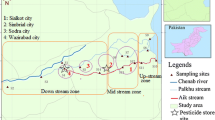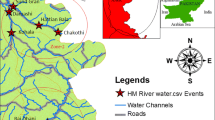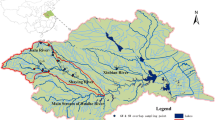Abstract
The levels of 17 organochlorine pesticides residues (OCPs) in surface water and sediments from Tamiraparani river basin, South India were investigated to evaluate their potential pollution and risk impacts. A total of 96 surface water and sediment samples at 12 sampling stations were collected along the river in four seasons during 2008–2009. The ΣOCP concentrations in surface water and sediments were in the range of 0.1 to 79.9 ng l−1 and 0.12 to 3,938.7 ng g−1 dry weight (dw), respectively. Among the OCPs, the levels of dichlorodiphenyltrichloroethanes (DDTs), aldrin, dieldrin, cis-chlordane, trans-chlordane, and mirex were dominant in the sediments. The dominant OCPs in water samples are heptachlor, o,p′-DDE, dieldrin, o,p′-DDD, and mirex, which show different source of contamination pattern among sampling seasons. The distribution pattern of DDTs, hexachlorocyclohexane, and other OCPs in the present study shows heterogenic nature of nonpoint source of pollution. Notable contamination of water and sediment sample that was observed in upstream (S2) 58 ng l−1 and downstream (S11) 1,693 ng g−1 dw explains agricultural and municipal outfalls, whereas frequent damming effect reduces the concentration level in the midstream. The overall spatial–temporal distribution pattern of ΣOCP residues are illustrated by GIS package.




Similar content being viewed by others
References
Ahmed, A., Barbary, El, Yehia, M. M., Mohamed, M., & Bouraie, El. (2008). Evaluation of organochlorine pesticides (OCPs) in surface water and bed sediment samples from the river Nile at Rosetta Branch, Egypt. Journal of Applied Sciences Research, 4, 1985–1993.
ATSDR. (1989). Public health statement for aldrin and dieldrin. Atlanta: US Department of Health and Human Services, Public Health Service.
ATSDR. (1997). Tox FAQs for endrin. Atlanta: US Department of Health and Human Services, Public Health Service.
ATSDR. (2002). Toxicological profile for aldrin/dieldrin. Atlanta: US Department of Health and Human Services, Public Health Service.
Awofolu, R. O., & Fatoki, O. S. (2003). Persistent organochlorine pesticide residues in freshwater systems and sediments from the Eastern Cape, South Africa. Water SA, 29, 323–330.
Balakrishnan, G., Ramachandran, M., Banerjee, B. D., & Hussain, Q. Z. (1985). Effect of dietary protein, dichlorodiphenyltrichloroethane (DDT) and hexachlorocyclohexanes (HCH) on hepatic microsomal enzyme activity in rats. British Journal of Nutrition, 54, 563–566.
Bossi, R., Laesen, B., & Premazze, G. (1992). Polychlorinated biphenyl congeners and other chlorinated hydrocarbons in bottom sediment cores of Lake Garden (Italy). Science of the Total Environment, 121, 77–93.
Burrough, P. A. (1986). In principles of geographical information systems for land resource assessment (pp. 104–156). Oxford: Clarendon.
Chauhan, R. S., & Singhal, L. (2006). Harmful effects of pesticides and their control through cowpathy. International Journal of Cow Science, 2, 61–70.
Darko, G., Akoto, O., & Oppong, C. (2008). Persistent organochlorine pesticide residues in fish, sediments and water from Lake Bosomtwi, Ghana. Chemosphere, 72, 21–24.
Doong, R. A., Sun, Y. C., Liao, P. L., Peng, C. K., & Wu, S. C. (2002). Distribution and fate of organochlorine pesticide residues in sediments from the selected rivers in Taiwan. Chemosphere, 48, 237–246.
Doong, R. A., Lee, S. H., Lee, C. C., Sun, Y. C., & Wu, S. C. (2008). Characterization and composition of heavy metals and persistent organic pollutants in water and estuarine sediments from Gao-ping river, Taiwan. Marine Pollution Bulletin, 57, 846–857.
Falandysz, J., Brudnowska, B., Kawano, M., & Wakimoto, T. (2001). Polychlorinated biphenyls and organochlorine pesticides in soils from the southern part of Poland. Archives of Environmental Contamination and Toxicology, 40, 173–178.
Iino, F., Sebesvari, Z., Renaud, F., Kitsuwa, T., Morita, M., Shibata, Y., et al. (2007). Pops analysis and monitoring in the Asian coastal hydrosphere. Organohalogen Compounds, 69, 1406–1409.
IPEP (2006). Country situation on persistent organic pollutants (POPs) in India, 1–57.
Iwata, H., Tanabe, S., Sakai, N., & Tatsukawa, R. (1993). Distribution of persistent organochlorines in the oceanic air and surface seawater and the role of ocean on their global transport and fate. Environmental Science and Technology, 27, 1080–1098.
Jensen, A. A. (1983). Chemical contaminants in human milk. Residue Reviews, 89, 1–128.
Jong, G.D. (1991). Long-term health effects of aldrin and dieldrin, a study of exposure, health effects and mortality of workers engaged in the manufacture and formulation of the insecticides aldrin and dieldrin. Toxicology Letters, 1–206.
Kim, J. H., & Smith, A. (2001). Distribution of organochlorine pesticides in soils from South Korea. Chemosphere, 43, 137–140.
Kurtz, D. A. (Ed.). (1990). Long range transport of pesticides. Chelsea: Lewis.
Loganathan, B. G., & Kannan, K. (1994). Global organochlorine contamination trends: an overview. Ambio, 23, 187–191.
Malik, A., Ojha, P., & Singh, K. P. (2009). Levels and distribution of persistent organochlorine pesticide residues in water and sediments of Gomti river (India)—a tributary of the Ganges river. Environmental Monitoring and Assessment, 148, 421–435.
Rajendran, R.B., & Subramanian, A.N. (1999). Chlorinated pesticide residues in surface sediments from the River Kaveri, South India. Journal of Environmental Science & Health Part B: Pesticides, Food Contaminants, and Agricultural Wastes (USA), 269–288.
Ramesh, R., & Anbu, M. (1996). Chemical methods for environmental analysis. Chennai: Macmillan India Ltd. 210.
Ravichandran, S., Ramanibai, R., & Pundarikanthan, N. V. (1996). Ecoregions for describing water quality patterns in Tamiraparani basin, South India. Journal of Hydrology, 178, 257–276.
Ravichandran, S. (2003). Hydrological influences on the water quality trends in Tamiraparani basin, South India. Environmental Monitoring and Assessment, 87, 293–309.
Rissato, S. R., Galhiane, M. S., Ximenes, V. F., de Andrade, R. M. B., Talamoni, J. L. B., Libanio, M., et al. (2006). Organochlorine pesticides and polychlorinated biphenyls in soil and water samples in the Northeastern part of Sao Paulo State, Brazil. Chemosphere, 65, 1949–1958.
Samoh, A. N. H., & Ibrahim, M. S. (2008). Organochlorine pesticide residues in the major rivers of Southern Thailand. Malaysian Journal of Analytical Sciences, 12, 280–284.
Sarkar, S. K., Bhattacharya, B. D., Bhattacharya, A., Chatterjee, M., Alam, A., Satpathy, K. K., et al. (2008). Occurrence, distribution and possible sources of organochlorine pesticide residues in tropical coastal environment of India: an overview. Environment International, 34, 1062–1071.
Singh, K. P., Malik, A., Mohan, D., & Takroo, R. (2005). Distribution of persistent organochlorine pesticide residues in Gomti river, India. Bulletin of Environmental Contamination and Toxicology, 74, 146–154.
Sood, C., & Bhagat, R. M. (2005). Interfacing geographical information systems and pesticide models. Current Science, 89, 8–25.
Subramanian, A., Ohtake, M., Kunisue, T., & Tanabe, S. (2007). High levels of organochlorines in mother’s milk from Chennai (Madras) city, India. Chemosphere, 68, 928–939.
UNEP. (2003). Global report on regionally based assessment of persistent toxic substances. Geneva: UNEP Chemicals.
USEPA. (1996). Method 3630, Revision C, EPA-737-F-96-005, Research Triangle Park, NC 27711.
Veeraiah, K., & Durga Prasad, M. K. (1996). A study on the organochlorine pesticides residue input into Kolleru through Tammieleru river. Ecology Environmental and Conservation, 2, 83–86.
Xue, N., Zhang, D., & Xu, X. (2006). Organochlorinated pesticide multiresidues in surface sediments from Beijing Guanting reservoir. Water Research, 40, 183–194.
Xu, S., Dong, Y., Sun, C., Fenf, J., & Wang, L. (2000). Polychlorinated organic compounds in Yangtse river sediments. Chemosphere, 41, 1897–1903.
Yang, R., Ji, G., Zhoe, Q., Yaun, C., & Shi, J. (2005). Occurrence and distribution of organochlorine pesticides (HCH and DDT) in sediments collected from East China Sea. Environmental International, 31, 799–804.
Zhang, Z., Hong, H., Zhou, J., Yu, G., Chen, W., & Wang, X. (2002). Transport and fate of organochlorine pesticides in the River Wuchuan, Southeast China. Journal of Environmental Monitoring, 4, 435–441.
Zhang, Z., Dai, M., Hong, H., Zhou, J., & Yu, G. (2002). Dissolved insecticides and polychlorinated biphenyls in the Pearl river estuary and South China sea. Journal of Environmental Monitoring, 4, 922–928.
Zhang, Z. L., Hong, H. S., Zhou, J. L., Huang, J., & Yu, G. (2003). Fate and assessment of persistent organic pollutants in water and sediment from Minjiang river estuary, Southeast China. Chemosphere, 52, 1423–1430.
Zhou, R., Zhu, L., Yang, K., & Chen, Y. (2006). Distribution of organochlorine pesticides in surface water and sediments from Qiantang River, East China. Journal of Hazardous Materials, 137, 68–75.
Acknowledgments
The authors would like to thank the Department of Science and Technology (DST), University Grants Commission (UGC) for financial assistance. The service provided by UNU, Shimadzu Corporation, Japan for GC/MS analysis is highly acknowledged.
Author information
Authors and Affiliations
Corresponding author
Rights and permissions
About this article
Cite this article
Kumarasamy, P., Govindaraj, S., Vignesh, S. et al. Anthropogenic nexus on organochlorine pesticide pollution: a case study with Tamiraparani river basin, South India. Environ Monit Assess 184, 3861–3873 (2012). https://doi.org/10.1007/s10661-011-2229-x
Received:
Accepted:
Published:
Issue Date:
DOI: https://doi.org/10.1007/s10661-011-2229-x




